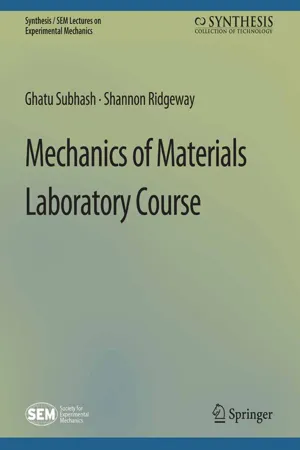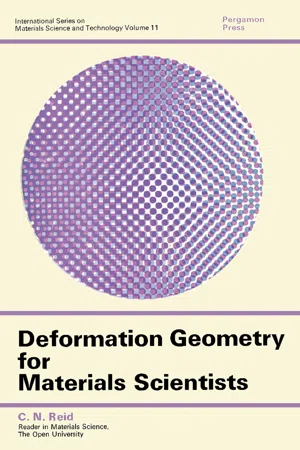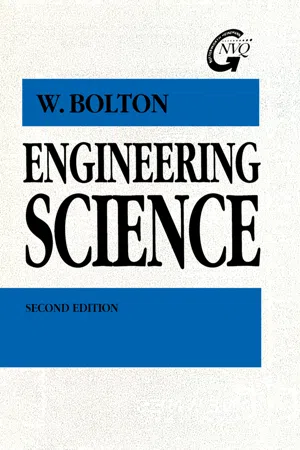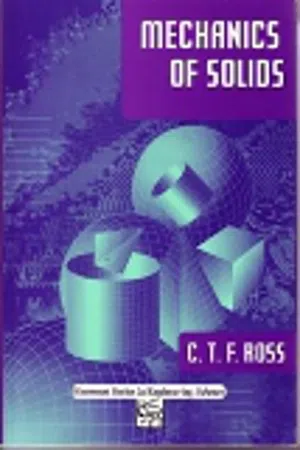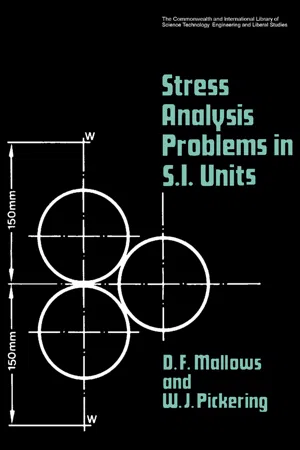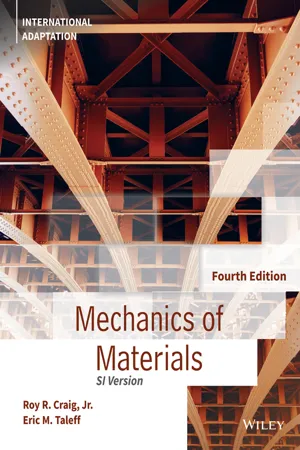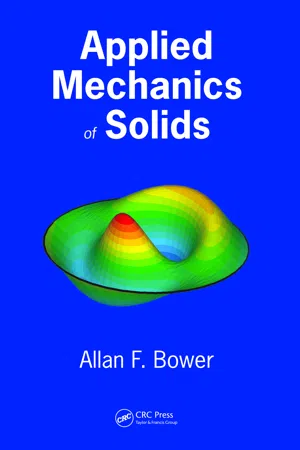Technology & Engineering
Stress and Strain
Stress and strain are fundamental concepts in the field of materials science and engineering. Stress refers to the internal force within a material, while strain is the measure of deformation caused by stress. Understanding the relationship between stress and strain is crucial for designing and analyzing the behavior of materials under different conditions.
Written by Perlego with AI-assistance
Related key terms
1 of 5
10 Key excerpts on "Stress and Strain"
- Wole Soboyejo(Author)
- 2002(Publication Date)
- CRC Press(Publisher)
3 ________________________ Basic Definitions of Stress and Strain 3.1 INTRODUCTION The mechanical properties of materials describe their characteristic responses to applied loads and displacements. However, most texts relate the mechanical properties of materials to stresses and strains. It is, therefore, important for the reader to become familiar with the basic definitions of Stress and Strain before proceeding on to the remaining chapters of this book. However, the well-prepared reader may choose to skip/skim this chapter, and then move on to Chap. 4 in which the fundamentals of elas-ticity are introduced. The basic definitions of Stress and Strain are presented in this chapter along with experimental methods for the measurement and application of strain and stress. The chapter starts with the relationships between applied loads/displacements and geometry that give rise to the basic definitions of strain and stress. Simple experimental methods for the measurement of strain and stress are then presented before describing the test machines that are often used for the application of strain and stress in the laboratory. 3.2 BASIC DEFINITIONS OF STRESS The forces applied to the surface of a body may be resolved into compo-nents that are perpendicular or parallel to the surface, Figs 3.1(a)-3.1(c). In 59 (a) 60 (b) Chapter 3 Simple tension,- eBook - PDF
- Ghatu Subhash, Shannon Ridgeway, Ghatu Zimmerman(Authors)
- 2022(Publication Date)
- Springer(Publisher)
87 L A B O R A T O R Y 3 Stress–Strain Response of Materials 88 3. STRESS–STRAIN RESPONSE OF MATERIALS PART A: THEORY 3.1 INTRODUCTION Structural components in engineering applications are subjected to complex loads and under- standing the influence of these loads is crucial to their safe design. However, because of the complexity of operating environment, we try to understand the material behavior in simplified loading conditions and then formulate failure theories for deformation behavior under complex combination of loads. To this end, we focus on material deformation under simple uniaxial (1D) tension and compression. Let us review two fundamental concepts in mechanics of materials. (i) Stress: Intensity of internal force at a given point. The intensity is measured as, internal force (P ) divided by area (A) at that location. Note that P is not the external applied force. The internal force is the resultant of all the applied external forces (and moments) acting at that point on a given cross sectional plane. To obtain resultant internal force, a cut section is made at that point and the forces are vectorially summed. For simple uniaxial loading along x-axis on a bar, the stress acting on a plane perpendicular to the loading axis is given by x D P =A (3.1) (ii) Strain: Change in length (dl )/original length (l ). If the change in length is in axial direc- tion x, then " x D dl=l (3.2) In both of the above equations, the denominators A and l refer to either original dimen- sions or current dimensions. If original dimensions are used, then they are called “engineering stress” and “engineering strain,” and if current dimensions are used, they are referred to as “true stress” and “true strain.” To conduct tension test (see Fig. 3.1), we typically use a dog bone-shaped specimen, grip it on two ends, and pull on it. The gage section is assumed to undergo uniform and uniaxial deformation and this deformation (elongation) is measured using an extensometer. - eBook - PDF
Deformation Geometry for Materials Scientists
International Series on Materials Science and Technology
- C. N. Reid, W. S. Owen(Authors)
- 2016(Publication Date)
- Pergamon(Publisher)
CHAPTER 1 T H E C O N C E P T S O F S T R E S S A N D S T R A I N To THE scientist and layman alike, deformation is the process by which a body changes its dimensions in response to impressed forces. We expect the load-bearing capacity to vary with the size of the body, and so the applied forces should be normalised with respect to the dimen-sions of the body. This leads us to the concept of stress. Similarly, the dimensional changes should also be normalised, leading to the definition of strain. Stress and Strain are the most intensively used words in the vocabulary of deformation and it is vital that we start with clear definitions of these terms, and a physical visualisation of what they mean. Unfortunately, the words Stress and Strain are used as alternatives in the vernacular, and most layman are unable to distinguish between them. On the other hand, to the scientist and engineer the terms are quite distinct, and confusion between them is inexcusable. Let us first discuss the concept of stress. STRESS We say that a body is under stress when one part of it exerts forces on neighbouring parts. Perhaps the most obvious examples involve bodies acted on by external forces, such as a chair under the weight of its occupant. However, external forces are not necessary for a state of stress, and bodies can exist in a state of internal stress. For example, suppose that we fully compress a helical spring and then solder together two adjacent turns of the helix. When the external compression is released, these turns will remain stressed, and we say that the spring contains internal stresses. The forces acting within a stressed body are either body forces or surface forces. Gravity is an example of a body force, and its magni-1 2 DEFORMATION GEOMETRY FOR MATERIALS SCIENTISTS tude depends on the volume of the body. Surface forces are exerted on the surfaces of the body by the surroundings, and the magnitude of these forces depends on the surface area of the body. - eBook - PDF
- J. Beddoes, M. Bibby(Authors)
- 1999(Publication Date)
- Butterworth-Heinemann(Publisher)
Stress and Strain during deformation The ingot and continuous casting operations, outlined in the previous chapter, rarely yield a finished product that does not need further processing. Typically, ingots or strands are further processed by one of several bulk deformation operations, often followed by additional shaping via sheet deformation, machining or joining. The prin- ciples that underlie all of these processes are presented in Chapters 4-8. However, to analyse deformation processes, an understanding of the relationships between stress, strain and deformation is necessary. These relationships are presented in this chapter. During metal deformation, large changes in part geometry may occur. It is often important to understand the consequences of the geometrical shape change on the internal structure of the metal. Externally, force and power are applied to deform the part. Internally, the part reacts based on its microstructure and properties. These internal and external effects can usually be quantified to some degree by calcu- lations involving the stress-strain relationships of the workpiece. In this chapter basic stress-strain concepts are briefly introduced to illustrate their usefulness for metal deformation problems. The response of a material to mechanical loads is often measured by a uniaxial tension test. A tensile specimen, such as shown in Fig. 3.1, is loaded with a force, F. The exten- sion of the sample, typically measured by a change in gauge length, is recorded and the results displayed as a load-extension curve. Load-extension curves characteristic of low carbon steel and many nonferrous metals are shown in Fig. 3.1. Since both load and extension are clearly dependent on specimen size, they are not unique mate- rial properties. Consequently, tensile test results are almost always expressed as Stress and Strain. Engineering stress is defined as F (3.1) O'a = A-~ where: t7 a is the engineering stress - eBook - PDF
- William Bolton(Author)
- 2016(Publication Date)
- Newnes(Publisher)
6 Stress and Strain Stress When a material is subject to external forces, such as those applied to stretch it, then internal forces are set up which oppose the external forces. The material can be considered to be rather like a spring. A spring is stretched by external forces, it sets up internal opposing forces which are readily apparent when the spring is released and they force it to contract. A measure of the intensity of the internal forces in a material created as a result of external forces being applied is stress. Stress is defined as the external force acting per unit area: The unit of stress is the pascal (Pa), where 1 Pa = 1 N/m 2 . Multiples of the pascal are generally used, e.g. the megapascal (MPa) which is 10 6 Pa and the gigapascal (GPa) which is 10 9 Pa. Because the area over which the forces act is more generally mm 2 rather than m 2 , it is useful to recognize that 1 GPa = 1 GN/m 2 = 1 kN/mm 2 and 1 MPa = 1 MN/m 2 = 1 N/mm 2 . The stress is said to be a direct stress when the area being stressed is at right angles to the line of action of the external forces. This is the case with materials in tension or in compression. A material in tension has had its length in the direction of the external forces increased; when in compression it is shortened. The convention is to designate tensile stresses as positive and compressive stresses as negative. Shear stresses are not direct stresses, the forces being applied in the same plane as the area being stressed (see later this chapter). The area used in the calculation of the stress is generally the original area that existed before the stress occurred. This stress is sometimes referred to as the engineering stress. The true stress would be the force divided by the actual area existing in the stressed state. Example 1 A bar of material with a cross-sectional area of 50 mm 2 was subjected to tensile forces of 0.1 kN. - eBook - PDF
- Carl T. F. Ross(Author)
- 1999(Publication Date)
- Woodhead Publishing(Publisher)
-~e---Stress and Strain 2.1 Introduction The most elementary definition of stress is that it is the load per unit area acting on a surface, rather similar to pressure, except that it can be either tensile or compressive and it does not necessarily act normal to the surface, i.e. Stress = load/area (2.1) In its simplest form, stress acts at an angle to the surface, as shown in Figure 2.1. However, in the form shown in Figure 2.1, it is difficult to apply stress analysis to practical problems, and because of this, the resultant stress is represented by a normal or direct stress a, together with a shear stress, t, as shown in Figure 2.2. The stress, a, in Figure 2.2 is called a normal or direct stress because it acts Figure2.1 Figure 2.2 Normal and shear stress 54 Stress and Strain 55 ~//.//.//./L • F Figure 2.3 Shearingaction of F Figure 2.4 Componentsof R perpendicularly to the surface under consideration, and the stress, r, is called a shearing stress because it acts tangentially to the surface, causing shearing action, as shown in Figure 2.3. Thus, if a flat surface is subjected to a force, R, acting at an angle to the surface, it is convenient to represent this resultant force by its two perpendicular components, namely P and F, where P acts normal to the surface and F acts tangentially to the surface, as shown in Figure 2.4. The effect of P will be to increase the length of the structural component and to cause a normal or direct stress, a, where a=PjA (2.2) and A is the cross-sectional area. - eBook - PDF
- William F. Hosford(Author)
- 2009(Publication Date)
- Cambridge University Press(Publisher)
1 Stress and Strain Introduction This book is concerned with the mechanical behavior of materials. The term mechanical behavior refers to the response of materials to forces. Under load, a material may either deform or break. The factors that govern a material’s resistance to deforming are quite different than those governing its resistance to fracture. The word strength may refer either to the stress required to deform a material or to the stress required to cause fracture; therefore, care must be used with the term strength . When a material deforms under small stresses, the deformation may be elastic . In this case, when the stress is removed, the material will revert to its original shape. Most of the elastic deformation will recover immediately. There may be, however, some time-dependent shape recovery. This time-dependent elastic behavior is called anelasticity or viscoelasticity . Larger stresses may cause plastic deformation. After a material undergoes plas-tic deformation, it will not revert to its original shape when the stress is removed. Usually, high resistance to deformation is desirable so that a part will maintain its shape in service when stressed. However, it is desirable to have materials deform easily when forming them by rolling, extrusion, and so on. Plastic deformation usu-ally occurs as soon as the stress is applied. At high temperatures, however, time-dependent plastic deformation called creep may occur. Fracture is the breaking of a material into two or more pieces. If fracture occurs before much plastic deformation occurs, we say the material is brittle . In contrast, if there has been extensive plastic deformation preceding fracture, the material is con-sidered ductile . Fracture usually occurs as soon as a critical stress has been reached; however, repeated applications of a somewhat lower stress may cause fracture. This is called fatigue . The amount of deformation that a material undergoes is described by strain. - eBook - PDF
Stress Analysis Problems in S.I. Units
The Commonwealth and International Library: Mechanical Engineering Division
- D. F. Mallows, W. J. Pickering, N. Hiller(Authors)
- 2013(Publication Date)
- Pergamon(Publisher)
CHAPTER 2 Stress and Strain Definitions and Theory (a) Direct stress. The direct stress/set up by a tensile or compressive force F acting perpendicular to the cross-sectional area A of an elastic material (Fig. 2.1) is defined a s / = F/A with the sign convention that tensile forces and stresses are positive and compressive forces and stresses are negative. Area A FIG. 2.1. Diagram for definition of direct stress. Area A' FIG. 2.2. Diagram for definition of shear Stress and Strain. (b) Shear stress. Parallel forces F acting in opposite directions on a material as in Fig. 2.2 produce shear stresses q, where q = F/A 9 where A is not the cross-sectional area but the area being sheared. 34 Stress and Strain 35 (c) Strain. This is the measure of deformation of a material carrying stress. Direct strains are caused by direct stresses and have the symbol e, where __ change in length __ x original length ~ L ' compressive strains negative, tensile positive. Shear strain symbol φ is defined with reference to Fig. 2.2 as φ = x'jL but since strains in an elastic material are usually very small, the shear strain is approxi-mately equal to the angle φ measured in radians. Strain is a dimension-less number and therefore has no units. (d) Elastic moduli. Within the range of stresses and strains used in many engineering applications it is found that the ratio of stress to strain is a constant. The constant is called the elastic modulus and is named for uniaxial direct tension or compression, shear, and for hydrostatic pressure as: (i) Uniaxial direct stress : Young's modulus or modulus of elas-ticity (E). (ii) Shear: Modulus of rigidity (G). (iii) Hydrostatic pressure (equal compressive stress on all surfaces of a solid body). Bulk modulus (K) defined as K = p/(Av/v) where p is the pressure, Av is the change in volume, v is the original volume, and Av/v is called volumetric strain. - Roy R. Craig, Jr., Eric M. Taleff(Authors)
- 2023(Publication Date)
- Wiley(Publisher)
As noted earlier, most materials have a value of v that falls within the range v = 0.25 to v = 0.35. 92 Chapter 2 Stress and Strain Chapter Review Section Suggested Review Problems 2.1 Section 2.1 points out the need for defi- nitions of Stress and Strain in order to explain how force is distributed through- out a deformable body under load and how the body deforms point by point. You should familiarize yourself with this material. 2.2 Section 2.2 defines stress as “Force divided by Area.” Normal stress is nor- mal, that is, perpendicular to the plane on which it acts, and it is denoted by the Greek symbol sigma (σ). Figure 2.2 and Eqs. 2.1 and 2.2 define: • Normal stress at a point y, z on cross section x. • Average normal stress on cross sec- tion x. Normal Stress σ ( , , ) lim x y z F A A = Δ Δ Δ →0 (2.1) σ avg = F A (2.2) z y z z z R y x x x R ( a ) Distributed normal stress on a cross section. ( b ) Resultant of distributed normal stress in (a). ∆ F ∆A F( x ) y y R Normal force on a cross section (Fig. 2.2) The sign convention for normal stress is: • Positive normal stress is called tensile stress. • Negative normal stress is called com- pressive stress. The normal stress on cross sections of an axially loaded member is called axial stress. The resultant normal force on the cross section must act through the cen- troid. Axial Stress σ i i i F A = (2.5) x F i F(x) = F i σ Normal force through centroid (Fig. 2.4b) 2.2-3 2.2-9 2.2-15 2.3 Section 2.3 defines extensional strain, the strain that goes with normal stress. Extensional Strain = ΔL L (2.7) A B C D E F L (a) The undeformed bar. A* B* C* D* E* F* L L* ∆L (b ) The deformed bar. Extensional strain (Fig. 2.5) 2.3-7 2.3-11 Chapter Review 93 Section Suggested Review Problems Section 2.3 also defines thermal strain, the strain that is produced by a change in temperature. = α ΔT where α is the coefficient of thermal expansion and ΔT is the change in temperature from the reference temperature.- eBook - PDF
- Allan F. Bower(Author)
- 2009(Publication Date)
- CRC Press(Publisher)
65 3 Constitutive Models: Relations between Stress and Strain The equations listed in Chapter 2 are universal: they apply to all deformable solids. Th ey can-not be solved, however, unless the deformation measure can be related to the internal forces. The constitutive model for a material is a set of equations relating stress to strain (and possibly strain history, strain rate, and other field quantities). Unlike the governing equa-tions in the previous chapter, these equations cannot generally be calculated using fun-damental physical laws (although people are trying to do these calculations). Instead, constitutive models are fit to experimental measurements. Before discussing specific constitutive models, it is helpful to review the basic assump-tions that we take for granted in developing stress-strain laws. They are listed below: A very small sample that is extracted from the solid has uniform properties. When the solid is deformed, initially straight lines in the solid are deformed into smooth curves (with continuous slope), as shown in Figure 3.1. This means that very short line segments (much shorter than the radius of curvature of the curves) are just stretched and rotated by the deformation. Consequently, the • • • Original configuration Deformed configuration e 2 e 1 e 3 FIGURE 3.1 Deformation of an internal material element in a solid. 66 ◾ Applied Mechanics of Solids deformation of a suffi ciently small volume element can be characterized by the defor-mation gradient. The stress at a point in the solid depends only on the change in shape of a vanishingly small volume element surrounding the point. It must therefore be a function of the deformation gradient or a strain measure that is derived from it. If we accept the preceding assumptions, it means that we can measure the relationship between Stress and Strain by doing an experiment that induces a uniform strain in a suit-able sample of the material.
Index pages curate the most relevant extracts from our library of academic textbooks. They’ve been created using an in-house natural language model (NLM), each adding context and meaning to key research topics.

